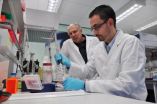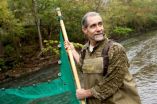(Press-News.org) A newly-developed, highly accurate representation of the way in which neurons behave when performing movements such as reaching could not only enhance understanding of the complex dynamics at work in the brain, but aid in the development of robotic limbs which are capable of more complex and natural movements.
Researchers from the University of Cambridge, working in collaboration with the University of Oxford and the Ecole Polytechnique Fédérale de Lausanne (EPFL), have developed a new model of a neural network, offering a novel theory of how neurons work together when performing complex movements. The results are published in the18 June edition of the journal Neuron.
While an action such as reaching for a cup of coffee may seem straightforward, the millions of neurons in the brain's motor cortex must work together to prepare and execute the movement before the coffee ever reaches our lips. When reaching for the much-needed cup of coffee, the millions of neurons in the brain's motor cortex spring into action, sending a series of signals from the brain to the hand. These signals are transmitted across synapses – the junctions between neurons.
Determining exactly how the neurons work together to execute these movements is difficult, however. The new theory was inspired by recent experiments carried out at Stanford University, which had uncovered some key aspects of the signals that neurons emit before, during and after the movement. "There is a remarkable synergy in the activity recorded simultaneously in hundreds of neurons," said Dr Guillaume Hennequin of the University's Department of Engineering, who led the research. "In contrast, previous models of cortical circuit dynamics predict a lot of redundancy, and therefore poorly explain what happens in the motor cortex during movements."
Better models of how neurons behave will not only aid in our understanding of the brain, but could also be used to design prosthetic limbs controlled via electrodes implanted in the brain. "Our theory could provide a more accurate guess of how neurons would want to signal both movement intention and execution to the robotic limb," said Dr Hennequin.
The behaviour of neurons in the motor cortex can be likened to a mousetrap or a spring-loaded box, in which the springs are waiting to be released and are let go once the lid is opened or the mouse takes the bait. As we plan a movement, the 'neural springs' are progressively flexed and compressed. When released, they orchestrate a series of neural activity bursts, all of which takes place in the blink of an eye.
The signals transmitted by the synapses in the motor cortex during complex movements can be either excitatory or inhibitory, which are in essence mirror reflections of each other. The signals cancel each other out for the most part, leaving occasional bursts of activity.
Using control theory, a branch of mathematics well-suited to the study of complex interacting systems such as the brain, the researchers devised a model of neural behaviour which achieves a balance between the excitatory and inhibitory synaptic signals. The model can accurately reproduce a range of multidimensional movement patterns.
The researchers found that neurons in the motor cortex might not be wired together with nearly as much randomness as had been previously thought. "Our model shows that the inhibitory synapses might be tuned to stabilise the dynamics of these brain networks," said Dr Hennequin. "We think that accurate models like these can really aid in the understanding of the incredibly complex dynamics at work in the human brain."
Future directions for the research include building a more realistic, 'closed-loop' model of movement generation in which feedback from the limbs is actively used by the brain to correct for small errors in movement execution. This will expose the new theory to the more thorough scrutiny of physiological and behavioural validation, potentially leading to a more complete mechanistic understanding of complex movements.
INFORMATION:
For more information, contact:
Sarah Collins
Office of Communications, University of Cambridge
Tel: +44 (0)1223 332300 Mob: +44 (0)7525 337458
sarah.collins@admin.cam.ac.uk
Notes to editors:
The paper, "Optimal Control of Transient Dynamics in Balanced Networks Supports Generation of Complex Movements" is published in the June 18th edition of the journal Neuron.
Modeling how neurons work together
2014-06-18
ELSE PRESS RELEASES FROM THIS DATE:
Stem pipeline problems to aid STEM diversity
2014-06-18
PROVIDENCE, R.I. [Brown University] — Decades of effort to increase the number of minority students entering the metaphorical science, technology, engineering, and math (STEM) pipeline, haven't changed this fact: Traditionally underrepresented groups remain underrepresented. In a new paper in the journal BioScience, two Brown University biologists analyze the pipeline's flawed flow and propose four research-based ideas to ensure that more students emerge from the far end with Ph.D.s and STEM careers.
Senior author Andrew G. Campbell, associate professor of biology, said ...
Nanoparticles from dietary supplement drinks likely to reach environment, say scientists
2014-06-18
Nanoparticles are becoming ubiquitous in food packaging, personal care products and are even being added to food directly. But the health and environmental effects of these tiny additives have remained largely unknown. A new study now suggests that nanomaterials in food and drinks could interfere with digestive cells and lead to the release of the potentially harmful substances to the environment. The report on dietary supplement drinks containing nanoparticles was published in the journal ACS Sustainable Chemistry & Engineering.
Robert Reed and colleagues note that food ...
BU-lead study shows surprising spread of spring leaf-out times
2014-06-18
(Boston) – Despite conventional wisdom among gardeners, foresters and botanists that woody plants all "leaf out" at about the same time each spring, a new study organized by a Boston University biologist found a surprisingly wide span of as much as three months in leaf-out times. Significantly, observations the past two springs of 1,597 woody plants in eight botanical gardens in the U.S., Canada, Germany and China suggest that species differences in leaf-out times could impact the length of the growing season and the activities of birds, insect and other animals and therefore ...
Innovative technologies in rural areas improve agriculture, health care
2014-06-18
TAMPA, Fla. (June 18, 2014) – The current special issue of Technology and Innovation is devoted to articles on both innovations in rural regions and general articles on technology and innovation, including an article from the National Academy of Inventors (NAI) by McDevitt et al. that discusses the value of technology transfer for universities beyond money.
The five papers in this special issue of Technology and Innovation dealing with innovations in rural regions include an editorial, an analysis of the value of networks for European organic farmers and conventional ...
Self-repairing mechanism can help to preserve brain function in neurodegenerative diseases
2014-06-18
New research, led by scientists at the University of Southampton, has found that neurogenesis, the self-repairing mechanism of the adult brain, can help to preserve brain function in neurodegenerative diseases such as Alzheimer's, Prion or Parkinson's.
The progressive degeneration and death of the brain, occurring in many neurodegenerative diseases, is often seen as an unstoppable and irrevocable process. However, the brain has some self-repairing potential that accounts for the renewal of certain neuronal populations living in the dentate gyrus, a simple cortical region ...
When it comes to numbers, culture counts
2014-06-18
CAMBRIDGE, MA -- American children learn the meanings of number words gradually: First they understand "one," then they add "two, "three," and "four," in sequence. At that point, however, a dramatic shift in understanding takes place, and children grasp the meanings of not only "five" and "six," but all of the number words they know.
Scientists have also seen this pattern in children raised speaking other languages, including Japanese and Russian. In all of these industrialized nations, number learning begins around age 2, and children fully understand numbers and counting ...
3D breast imaging could revolutionize cancer screening
2014-06-18
Leesburg, VA, June 17, 2014—In community-based radiology practice, mammography screening with 3D digital breast tomosynthesis (DBT) yielded lower recall rates, an increased overall cancer detection rate, and an increased detection rate for invasive cancer compared with 2D digital mammography (DM).
In the largest report to date, researchers at Washington Radiology Associates, PC, with offices in Washington, DC; Virginia; and Maryland, conducted a study of more than 59,000 patients. The results were striking: an increase in the detection rate for cancer overall of 28.6% ...
Exposure to TV violence related to irregular attention and brain structure
2014-06-18
INDIANAPOLIS -- Young adult men who watched more violence on television showed indications of less mature brain development and poorer executive functioning, according to the results of an Indiana University School of Medicine study published online in the journal Brain and Cognition.
The researchers used psychological testing and MRI scans to measure mental abilities and volume of brain regions in 65 healthy males with normal IQ between the age of 18 and 29, specifically chosen because they were not frequent video game players.
Lead author Tom A. Hummer, Ph.D., assistant ...
Wildlife scientists map fishing resources to assist land managers, anglers
2014-06-18
Anglers in North Carolina and Virginia who are looking for privacy at good fishing spots should head for the mountains, according to a Virginia Tech study of the capacity, quality, and demand of freshwater recreational fishing sites in the two states.
"Our objective was to map a cultural ecosystem service by identifying the key features that influence anglers' enjoyment, such as environmental quality, accessibility, and fish abundance," said Amy Villamagna, a research scientist with the College of Natural Resources and Environment's fish and wildlife conservation department. ...
New method to identify inks could help preserve historical documents
2014-06-18
The inks on historical documents can hold many secrets. Its ingredients can help trace trade routes and help understand a work's historical significance. And knowing how the ink breaks down can help cultural heritage scientists preserve valuable treasures. In a study published in the Journal of the American Chemical Society, researchers report the development of a new, non-destructive method that can identify many types of inks on various papers and other surfaces.
Richard Van Duyne, Nilam Shah and colleagues explain that the challenge for analyzing inks on historical ...



